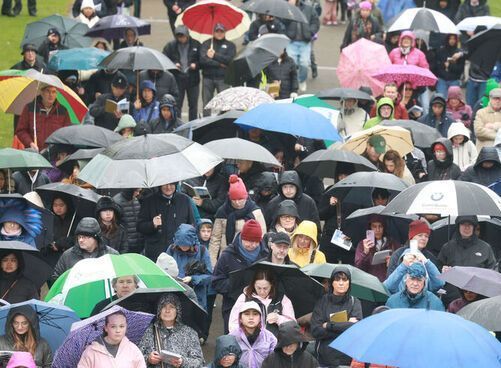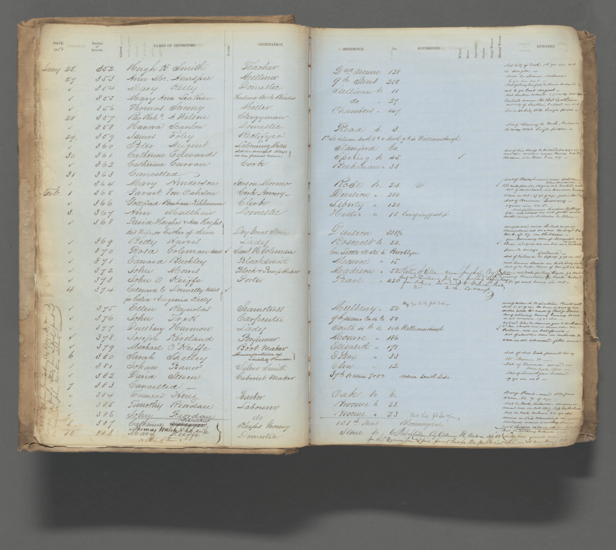Consul General Ciarán Madden.
By Peter McDermott
Consul General Ciarán Madden began to notice something about the events he attended and spoke at when he was first in the job. And that was they had almost exclusively white audiences.
“They were not reflective of the United States,” he said, “and not reflective increasingly of Ireland.”
“How do we change that?” asked Ireland’s top diplomat to New York.
Madden was speaking at a 5-6 p.m. Zoom event on Feb. 25, organized by the United Federation of Teachers’ Irish Studies Committee in joint celebration of Black History Month and Irish Heritage Month.
Madden said he started looking into the issue and found that some people had been working on it for decades, including musician and scholar Mick Moloney and cultural historian Lenwood Sloan, the fourth and fifth guest speakers introduced on Zoom by the committee’s co-chair Doris Meyer. (The first item on the meeting’s agenda was a presentation by Rachael Gilkey and Jessie Reilly on programming at the Irish Arts Center that is of particular interest and relevance to educators.)
A year ago, Madden participated in the launch of the African-American Irish Diaspora Network. It was the worst possible time to begin something, he suggested, “but they’ve managed to have a lot of events since.”
Madden listed several initiatives and happenings that have taken place in the past 12 months, whether under that group’s auspices or those of others, among them some well-established institutions. “All of these small events have been like sending up a flare,” he said.
The world of DNA has opened up this area considerably, too, as it’s been estimated that a third of African-Americans have some Irish roots. This means that many people are now anxious to explore a part of their heritage that was not handed down to them.
“Some have not felt welcomed, as they’ve turned towards their Irish heritage,” Madden said. “But we are there as Irish America, we are there as the Irish government, we are there as Ireland to welcome them and help them explore their heritage.
“The Consulate is honored to be part of this,” he said.
Madden added, “The government’s voice is important because we can reach places others can’t.”
He argued that as people celebrate the more “positive connections,” they must also be honest about the “darker parts of it.”
Madden said, “Some of this will come from hard places. We have to put our hands up and acknowledge that.”
Frederick Douglass received a warm welcome in Ireland 175 years ago, but he was also critical of the racial attitudes of the Irish in this country. In that regard, Madden mentioned the Young Ireland revolutionary John Mitchel, seen as a hero in Irish America, though he was militantly pro-slavery and pro-Confederacy.
The relationship between those of African descent in the Western Hemisphere and the Irish has been a “troubled one,” said Moloney, as began his contribution.

Lenwood Sloan.
“We are used to considering ourselves as victims, and it’s a narrative that can certainly be sustained by evidence,” he said, “One of the most uncomfortable things for some of our audiences of Irish ancestry is, when we’ve given this presentation, we are now starting to assume the role of perpetrator. We’re not used to that; but there are always redemptive moments. In a story like this, it would be a very harrowing tale if there weren’t these redemptive moments.”
The presentation referred to, which he has done with Sloan over many years, focuses on a few of those redemptive moments. One is the evolution of the roots of American music, such as old-time music in the Appalachians, bluegrass and country.
“America’s most distinctive songs from the early years of settlement had a very heavy imprint of two cultures,” he said. “Gaelic melody from the Irish and Scottish side of things, fiddle music, and the pulsating backbeat of Africa.”
Moloney spoke of an instrument he plays, the banjo, which was not literally carried to America
but recreated here as a link to an ancestral homeland. In Monticello, he and Sloan learned that Jefferson wrote a lot about the banjo.
Sloan recalled another research library where he found want ads, which tell a story of Irish men and women on the edges of Appalachia escaping indentured servitude and hiding out.
“They looked very much like the slave bounty-hunter ads that I had been collecting where the same route was used,” he said.

Mick Moloney.
In his contribution, he delineated the various laws that would in time allow what was called “amalgamation,” for instance between “these indentured servants escaping and going one way and the slaves who are coming from the other direction.”
The narrative also includes, of course, what happened inside the structure of slavery, such as the tale of three brothers arriving from County Tyrone. Moloney cited the New York Times piece about how one of them married upward into a family of means and that he or another of the brothers impregnated a 14-year-old slave. The resulting child is a direct ancestor of First Lady Michelle Obama, the Times revealed.
“And Lenny you can multiply those stories,” Moloney said. “They’re on the edges, they’re unchronicled.”
Sloan replied, “This is not all about rapes on the plantation. For the majority of mixed-blood people between 1820 and 1865, it was the intermarriage on the edges, for security, for homesteading.”
Amalgamation was in a certain time and place practical because Black women and Irish men both had longer life expectancies than their counterparts.
Sloan spoke of the system of plaçage, whereby a Black woman “could place herself under the security of a white man, usually an Irishman. So even though it was not considered a legal marriage the couple lived as common-law husband and wife.”
But from the Civil War on, “instead of it becoming safety for these races to come together, it was illegal.” There was a short period, however, when it was Irish women who sought out Black men, as they were perceived to be upwardly mobile in jobs that later were considered quite menial, such as waitering. In time, though, the era of amalgamation, which Sloan dates from the late 18th century, was swept away by miscegenation laws.
The five speakers covered an impressive amount of material in the short time allotted, but it seemed the two scholars could have gone on all night.
Moloney said of his presentation with Sloan, which they’ve taken to the Smithsonian and overseas to Cuba, “We try to tailor it to where we’re at.
“You never know what’s going to happen. We throw a few slides up, videos,” he said. “We meet a couple of hours before and decide what we’re going to do.
“Lenny’s got stuff, I’ve got stuff,” Moloney said.









